Related Research Articles

The Nokia 3310 is a GSM mobile phone announced on 1 September 2000, and released in the fourth quarter of the year, replacing the popular Nokia 3210. It sold very well, being one of the most successful phones, with 126 million units sold worldwide, and being one of Nokia's most iconic devices. The phone is still widely acclaimed and has gained a cult status due to its reputation for durability.

Metro by T-Mobile is an American prepaid wireless service provider and brand owned by T-Mobile US. It previously operated the fifth largest mobile telecommunications network in the United States using code-division multiple access (CDMA). In 2013, the carrier engaged in a reverse merger with T-Mobile US; post-merger, its services were merged under T-Mobile's UMTS and LTE network. Metro by T-Mobile competes primarily against Dish's Boost Mobile, AT&T's Cricket Wireless and Verizon's Visible as part of the wireless service provider brands.
Vertu is a British-based manufacturer and retailer of luxury handmade mobile phones, established by Finnish mobile-phone manufacturer Nokia in 1998.

The Nokia 6020 and 6021 are feature phones made by Nokia, running the Series 40 platform. The Nokia 6020 has a camera and no Bluetooth support, while the Nokia 6021 has Bluetooth and does not have a camera. The Nokia 6020 was introduced in November 2004 as a successor of the Nokia 6010 for Americas and the Nokia 3510i and also the Nokia 6230 for the global market. It was succeeded by the Nokia 6070 in 2006.

The Samsung SPH-N270 or Matrix phone is a bar style mobile phone released in 2003, made to resemble the phone used in The Matrix Reloaded. The design crew of the Matrix worked closely with Samsung to develop a phone whose features and release date would coincide with the movie. The SPH-N270 was not intended as a mainstream phone for everyday use. Instead, it was marketed solely to fans of the series as a piece of rare, high quality merchandise.
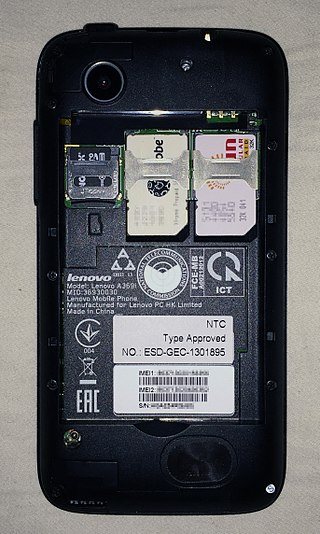
Some mobile phones support use of two SIM cards, described as dual SIM operation. When a second SIM card is installed, the phone either allows users to switch between two separate mobile network services manually, has hardware support for keeping both connections in a "standby" state for automatic switching, or has individual transceivers for maintaining both network connections at once.
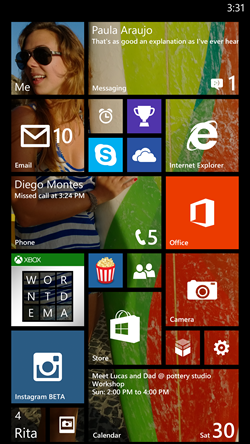
Windows Phone (WP) is a discontinued family of mobile operating systems developed by Microsoft for smartphones as the replacement successor to Windows Mobile and Zune. Windows Phone featured a new user interface derived from the Metro design language. Unlike Windows Mobile, it was primarily aimed at the consumer market rather than the enterprise market.

The Nokia E71 is a smartphone introduced in May 2008 from the Eseries range with a QWERTY keyboard targeting business users worldwide. It runs on Symbian OS v9.2, with a Series 60 3rd Edition, second generation Feature Pack 1. The Nokia E71 succeeded the Nokia E61/61i models, building on the base design and form factor but enhancing on the feature set.
Samsung Mobile Division is one of five divisions within Samsung Electronics, belonging to the Samsung Group, and consists of the Mobile Communications Division, Telecommunication Systems Division, Computer Division, MP3 Business Team, Mobile Solution Centre and Telecommunication R&D Centre. Telecommunication Business produces a full spectrum of products from mobiles and other mobile devices such as MP3 players and laptop computers to telecommunication network infrastructure. Headquarters is located in Suwon, South Korea.
The Nokia 2600 is an entry-level mobile phone by Nokia running Series 30. It was first announced in April 2004 in India, and on 14 June 2004 in Singapore and Helsinki, and some time later.

The LG Optimus One is an entry-level series of touch-screen smartphones manufactured by LG Electronics, Inc. It was released running the Android 2.2 Froyo, and later LG released software to upgrade it to Android 2.3 Gingerbread. Although the basic physical form factor of each variant is the same, the variants have differences in hard button shape and layout, the form of the metal side bezel and the user interfaces added by LG or various carriers. Versions of the Optimus One exist that operate on various frequency bands and either GSM or CDMA-based network protocols. They may also feature one or more variations in hardware, such as a faster processor, the addition of a physical keyboard, a modem with higher theoretical speeds, or a better digital camera.
Nokia's strategic nomenclature can be traced back in 2005 when the Nseries line was launched, offering devices with flagship specifications and premium hardware at various price points. These devices were considered the "bread and butter" of the company and were often positioned to showcase their latest technologies. Thanks to the newfound consumer and enterprise interest in smartphones at the time, the company introduced four additional collections to diversify their product portfolio and meet demands in most market segments. These new phone series were named Eseries, targeting small business and enterprise customers; Xseries, providing consumer-grade multimedia-focused devices; Cseries, which Nokia used to target both the low-end and mid-range market segments; and Tseries, for devices exclusive to the Chinese market.
An app store is a type of digital distribution platform for computer software called applications, often in a mobile context. Apps provide a specific set of functions which, by definition, do not include the running of the computer itself. Complex software designed for use on a personal computer, for example, may have a related app designed for use on a mobile device. Today apps are normally designed to run on a specific operating system—such as the contemporary iOS, macOS, Windows or Android—but in the past mobile carriers had their own portals for apps and related media content.

Nokia Lumia 800 is a smartphone from Nokia, first unveiled on 26 October 2011 at the Nokia World 2011 event. It originally ran on Windows Phone 7.5 "Mango" and was Nokia's first device to run the Windows Phone operating system marking the company's shift from Symbian for their smartphones. It was Nokia's flagship upon the original release in Europe in November 2011, and was thus also a highly important product for Nokia's mobile phone business.
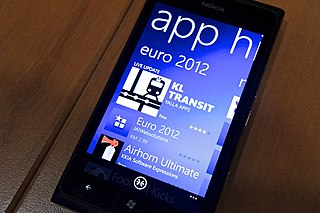
The Nokia Lumia 900 is a Windows Phone-powered smartphone, first unveiled on January 9, 2012 by Nokia at Consumer Electronics Show 2012, where it won the Best Smartphone award in January 2012. The phone has 4G LTE support and was released in April 2012. The Lumia 900 was the flagship smartphone of the Lumia range until the release of its successor, the Lumia 920.

Microsoft Lumia is a discontinued line of mobile devices that was originally designed and marketed by Nokia and later by Microsoft Mobile. Introduced in November 2011, the line was the result of a long-term partnership between Nokia and Microsoft—as such, Lumia smartphones run on Microsoft software, the Windows Phone operating system; and later the newer Windows 10 Mobile. The Lumia name is derived from the partitive plural form of the Finnish word lumi, meaning "snow".
The Huawei M835 is an Android mobile phone manufactured by Huawei and sold by MetroPCS. It was also known as C8500 or C8511.
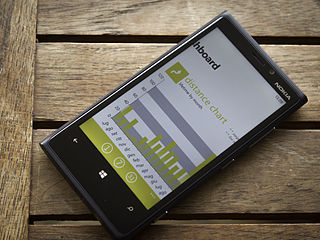
Nokia Lumia 920 is a smartphone developed by Nokia that runs the Windows Phone 8 operating system. It was announced on September 5, 2012, and was first released on November 2, 2012. It has a 1.5 GHz dual-core Qualcomm Krait CPU and a 4.5" IPS TFT LCD display, as well as a high-sensitivity capacitive touchscreen that can be used with gloves and fingernails; the display is covered by curved Gorilla Glass and has a 9 ms response time. The phone features an 8.7-megapixel PureView camera with OIS; it was the first smartphone camera to implement that technology, as well as to support Qi inductive charging. The phone comes with 32 GB of internal storage, but has no expandable storage.

The Nokia Lumia 520 is an entry-level Windows Phone 8 smartphone announced by Nokia at the 2013 Mobile World Congress.
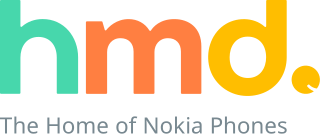
HMD Global Oy, branded as HMD and Nokia Mobile, is a Finnish mobile phone manufacturer. The company is made up of the mobile phone business that Nokia sold to Microsoft in 2014, then bought back in 2016. HMD began marketing Nokia-branded smartphones and feature phones on 1 December 2016. The company has exclusive rights to the Nokia brand for mobile phones through a licensing agreement. The HMD brand is only used for corporate purposes and does not appear in advertising, whereas the name "Nokia Mobile" is used on social media.
References
- ↑ Wolpin, Stewart (19 September 2005). "Nokia 2115i Shorty review - CNET" . Retrieved 26 August 2016.